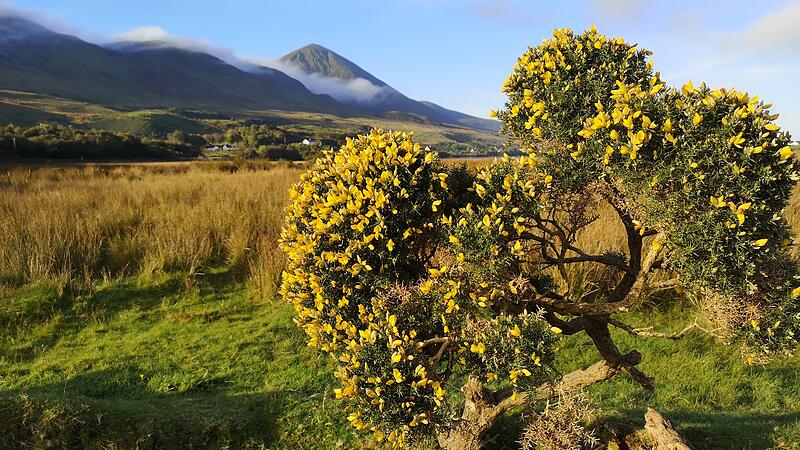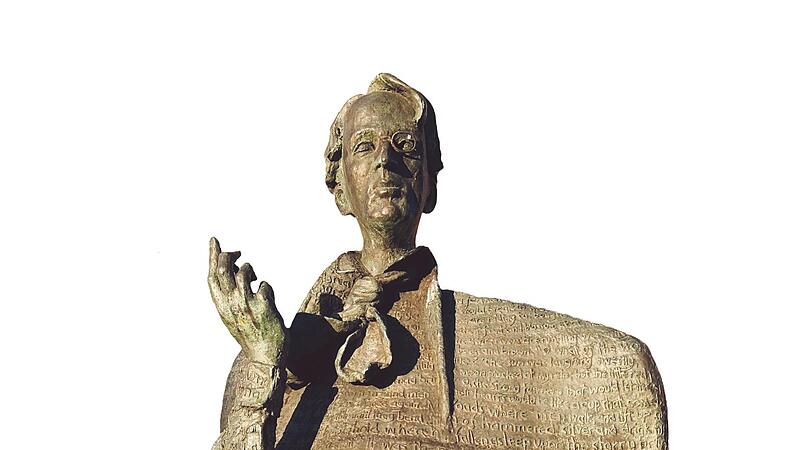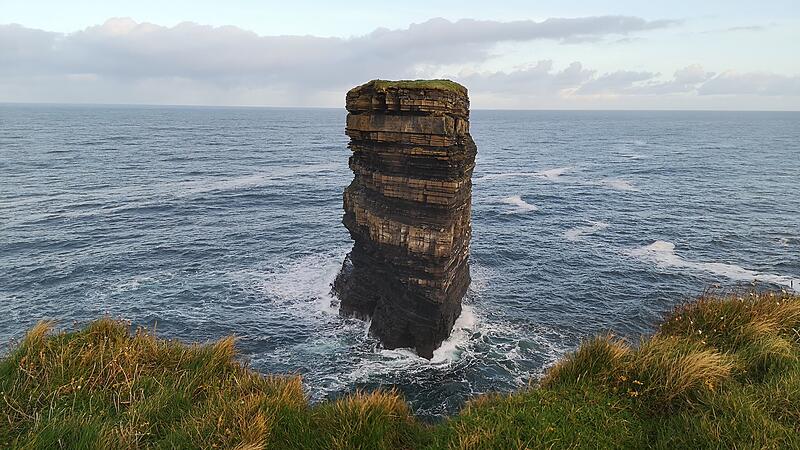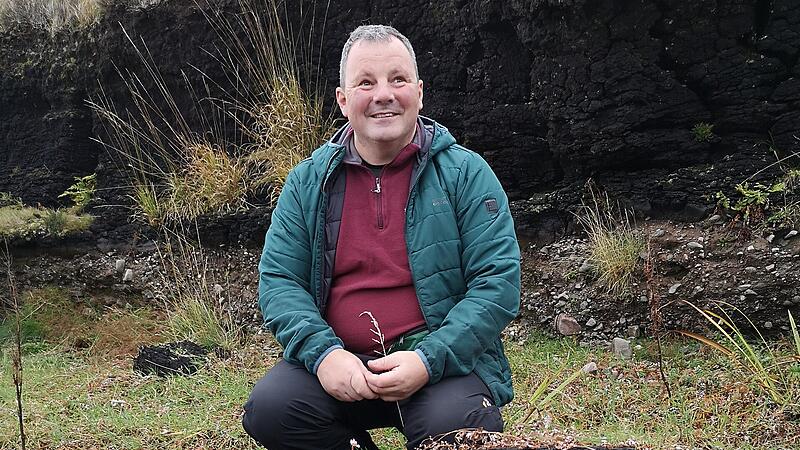“The rain here is absolute, magnificent and terrifying. To call this rain bad weather is as improper as it is to call the scorching sunshine fine weather.”(Heinrich Böll: Irish diary)
A faint glow had just squeezed through the low-lying cloud banks and settled on the crescent-shaped sandy beaches, snapped by the surf. Now wet is pattering against the face, stinging like the finest needles shot from a harpoon. On the pathless flank, at the end of which the rise of Croaghaun on the western tip of Achill Island can only be assumed, the storm is playing a perfidious game. If you defiantly turn your back on him, he will give in after a while. As if he had taken a deep breath, he hits with a powerful gust. “Kneel down. Make yourself small,” calls Gerard Mangan to the staggering people who are trying to get hold of themselves on all fours between the saturated swamp cushions. “Rain and fog aren’t a problem. It’s the wind that kills you,” says the experienced hiking guide and urges retreat. As if the said culprit had to emphasize what he said, he grabs a backpack cover and blows it down the valley.
And so what the German Nobel Prize winner Heinrich Böll, who regularly stayed in a small cottage in the village of Keel on Achill Island from 1954 onwards, wrote in his “Irish Diary” published in 1957, remains undone:
“Wild and as if created for the witches’ sabbath, covered with moor and heath, the Croghaun towers up, the westernmost of the European mountains, dropping 700 meters steeply towards the sea.”
The eight-person crew of a Royal Air Force aircraft, which was on a survey flight in 1950, never got to see the third highest cliffs in Europe. In the dense fog, the machine crashed on the mountain. The relics of the deadly accident – four engines – are still scattered today. As if in derision, on the slippery descent, the sun pushes aside the desolate curtain of sky and paints a glitter on the rippling waves of the dammed lake below. The common Irishman laconically comments on this roller coaster ride: “A wonderful day, all seasons at once.” The weather is a topic of conversation every day. However it behaves, whether sweet or dripping, in the end it is always given a “lovely” note. When it comes to feeling cold, it’s not uncommon to come across pain-free locals. As soon as the cloud cover reveals a gap, they tear the fabrics off their bodies and surrender their pallor to the rough Atlantic.

Image: beli
From the bridge that connects Achill to the mainland, which is itself an island, a scenic cycle path leads to Westport on Clew Bay. 117 islets stick out of the sea like sprinkles, only three are still inhabited all year round. In a park on Murrisk View, a bizarre monument – a ship in the shape of a coffin containing the dead – commemorates a bitter chapter in Irish history: it commemorates the great famine of the mid-19th century that killed millions or drove millions to emigrate. In the distance a cloud of fog reveals the peak of Croagh Patrick. Saint Patrick, the national saint, is said to have spent 40 days on this without food or water. In addition, the meditating hunger artist is credited with freeing the Emerald Isle from the snakes. On the last Sunday in July, tens of thousands of pilgrims wind their way up the 764-metre-high summit in his honour. Diehard penitents get bloody soles barefoot on the boulder-strewn path.
Under Ben Bulben’s bald hat, Yeats rests in Drumcliff’s churchyard. Once his ancestor was a pastor there, there is a little church at this place, an old high cross by the road. (WB Yeats: “Under Ben Bulben”)
One who believed found inspiration in another corner of the north-west of the Emerald Isle: William Butler Yeats (1865-1939), the first Irish winner of the Nobel Prize in Literature. “I believe in the vision of truth in the depths of the mind when the eyes are closed,” stated the poet, who turned to magic and Celtic myths in which fairies and otherworlds exist. Sligo was Yeats’ spiritual home, “the land of the heart’s longing”. In the city through which the Garavogue flows, the literary heritage is cultivated.


Image: beli
A bronze Yeats gracefully gestured and draped in a robe strewn with words stands in front of a bench. The national poet is laid to rest – as his poem anticipated – in nearby Drumcliff. The grave: plain, unadorned. The last lines of “Unter Ben Bulben” adorn the mottled stone:
“calm, rider,
see life, see death
and then move on!”
The cemetery seems left to transience. Ben Bulben, immortalized in the rhyme, rises in the background. A hiking trail leads along the foot of the imposing Table Mountain, which was formed by glaciers and is shrouded in legend, and a short stretch through a mystical, naturally grown vault of rhododendrons, mosses, ferns and lichens. Who doesn’t want to believe in fairies in this gloomy tunnel, who also have a taste for nasty things? Beware of them if you get lost in the fields on your nightly walk home from the pub. “Then you have to turn your jacket and hat around so they don’t recognize you,” explains accompanist David Lawless, explaining how you show the creatures your drunken tongue.
“. . . and is it fitting for a man to quench his thirst with well water or buttermilk?”(“Irish Diary”)
A “lovely day”, as the advertisement promises, requires a Guinness beer. Encountering Ireland without visiting a pub felt as wrong as avoiding casinos in Las Vegas. In the rustic drinking establishments on the densely populated Budel, calling for a pint of the liquid bread is considered good manners. The moor-colored stout with the creamy foam head, which in the best pouring case carries the weight of a coin, also goes well with a glass of Irish whiskey. And if it still happens that musicians gather in a niche for a session over a drink, driving melodies in front of them with fiddle, squeeze, nimble fingers on the tin whistle and wooden mallets dancing on the skin of the bodhrán, then nothing stands in the enrapture more in the way. If old quarrels like “Dirty Old Town”, “Whiskey in the Jar” or “Wild Rover” are intoned, people sing along heartily. The pub also pleases as the right place to chat with open-hearted people. “There are no strangers here, just friends who haven’t met yet,” said William Butler Yeats.


Image: beli
“Walls, walls, trees, walls and hedges: the stones of the Irish walls would suffice to build the Tower of Babel, but the Irish ruins prove that it would be futile to begin building it.” (“Irish Diary”)
Opposite Ben Bulben, on the other side of Sligo Bay, rises Knocknarea. Dry stone walls line the path to the hill, on which a huge cairn piles up. The burial mound, which is ten meters high, was built around 5000 years ago. That Maeve, goddess of war, who is said in Celtic mythology to strategically use the favor of her thighs, is part of the legend.
“. . .here is harvested what centuries of moisture have allowed to grow between bare rocks, lakes and green pastures: peat, the only natural wealth of a country that has been deprived of forest for centuries.” (“Irish Diary”)
Long gone are the days when the land was littered with cut peat briquettes stacked to dry in small pyramids. With the climate changed the realization of how valuable the moors are as carbon dioxide reservoirs. Anyone who builds a new house today has to do without an open fireplace, since no romantic argument will help. Farmers can still harvest peat, but they can no longer sell it – even if they don’t like it.


Image: beli
“It’s about a change of heart. We have to look to our country for future generations,” says Michael Chambers. The burly, stocky naturalist guide knows Wild Nephin National Park like the back of his hand and navigates the Bangor Trail through engaging, almost deserted terrain. The trained butcher, the youngest of nine children, fell in love with this landscape when his father told him the old stories – about the grandfather who hid in the caves like other rebels in the fight for freedom; from the mountains over which the eagle once circled. He sees himself as the guardian of the high moor, and when he initiates the secrets of flora and fauna, one hangs tensely on the lips of this poetic natural philosopher.
“When God made time, he made enough of it.” (Irish proverb)
This is also necessary in order to pick up not only the spots mentioned here, but also all the pearls that thread along the so-called Wild Atlantic Way, that signposted, 2500-kilometer-long coastal road from Malin Head in the north to Kinsale in the south: the extensive sandy beaches in rough Donegal; the beguiling landscape of Connemara; the village of Doolin, hailed as a mecca for traditional Irish music and the departure point for a boat trip to the Aran Islands; the sheer Cliffs of Moher, where those who hike to the last cliff avoid the flow of tourists; the Kingdom Greyhound Stadium in Tralee (just because greyhound racing, the betting sport of the common people, is a must-see); the ring around the Dingle Peninsula, which is preferable to the Ring of Kerry because it is less crowded, and, and, and…
Anyone who has ever tasted the charm of the Emerald Isle will in any case become a repeat offender.
information
- Accommodation: In the heart of Sligo on the Garavogue River is the Glasshouse Hotel (4 star), theglasshouse.ie
In Westport we recommend the central Castlecourt Hotel with restaurant, bistro and bar, castlecourthotel.ie - Pub: A popular venue for musical sessions is the ‘Hargadon Bros.’ on O’Vonnell Street in Sligo; best atmosphere at the “Porterhouse” on Bridge Street in Westport.
- Food: Eala Bhan Restaurant in Sligo, winner of the Irish Restaurant Award 2022
- reading material: Heinrich Böll’s “Irish Diary”, in which the later Nobel Prize winner for literature deals with his first encounters with Ireland in the 1950s (dtv paperback, 144 pages, 10.30 euros)
- Info: ireland.com
more from travel
A winter tour on the Lahngangkogel
(Conflict) rich and beautiful
Summer flights from Linz
Mondsee is one of the most beautiful campsites in Europe


My themes
For your saved topics
found new items.

info By clicking on the icon you add the keyword to your topics.
info
Click on the icon to open your “My Topics” page. They have of 15 tags saved and would have to remove tags.
info By clicking on the icon you remove the keyword from your topics.
Add the theme to your themes.
Source: Nachrichten



